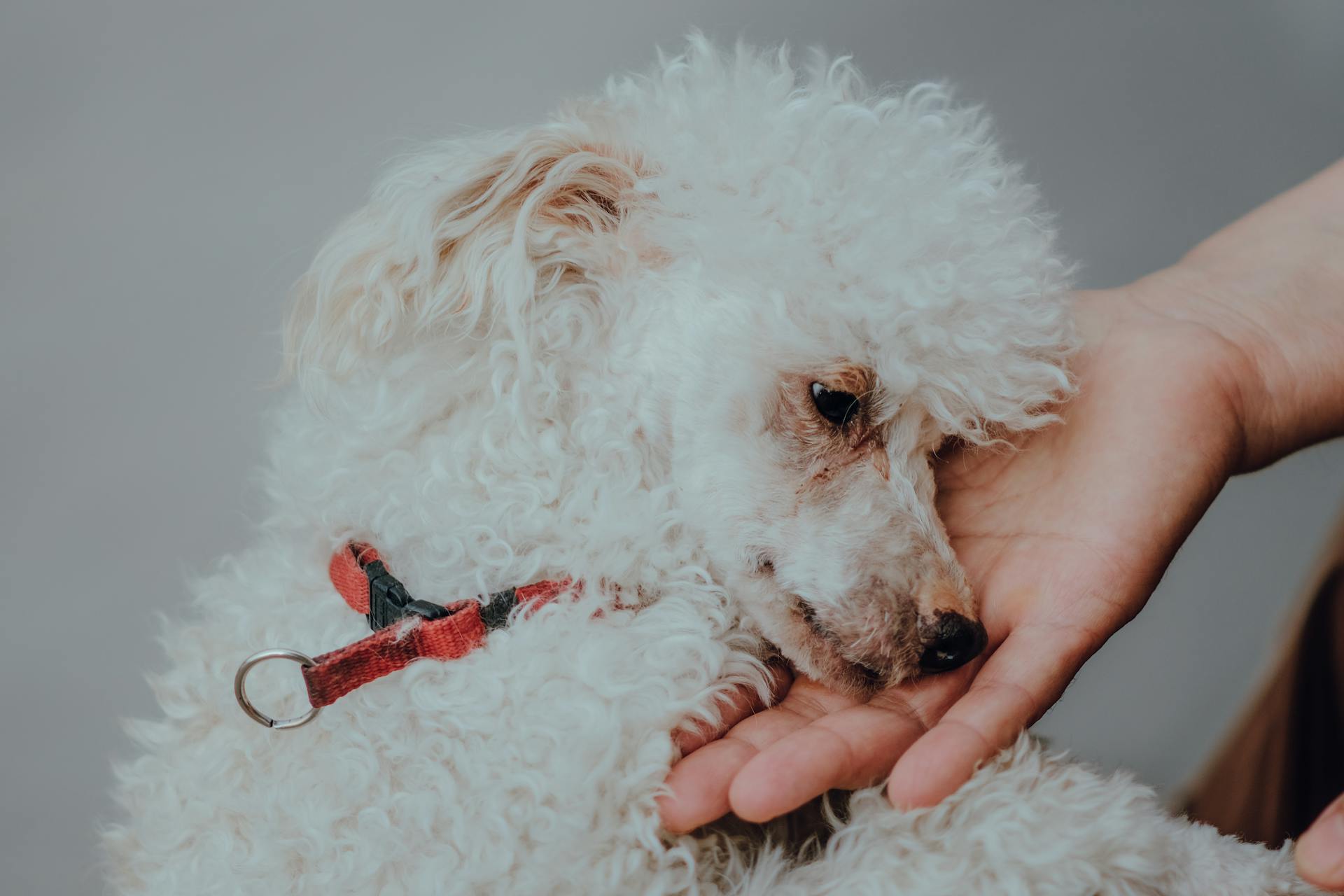
Shih Tzus are prone to skin problems, and one common issue is scabs.
Skin scabs on Shih Tzus can be caused by allergies, such as food or environmental allergies.
Shih Tzus with skin scabs may exhibit excessive scratching, chewing, or licking of the affected area.
Skin scabs can also be a sign of underlying skin conditions, like seborrhea or eczema.
If this caught your attention, see: Shih Tzu Food Allergies
Causes and Symptoms
Shih Tzu skin problems can be a real challenge for dog owners. Pseudomonas, a gram-negative rod-shaped bacterium, is often cultured from affected dogs and shampoos, and can cause post-grooming furunculosis.
Common symptoms of scaly skin in dogs include scratching, chewing, and licking at the skin, as well as scabs, red or irritated skin, and dandruff in the dog's bedding. These symptoms can be accompanied by uncharacteristic hair loss, bald patches, and a hot spot, or localized area of itching and biting.
Some breeds are more prone to scaly skin problems, including West Highland White Terriers, English Springer Spaniels, and Shih Tzus. If you suspect your Shih Tzu has scaly skin, look for flaky scales, lesions, and excessive scratching.
A dog's skin can become irritated and develop crusty scabs in various areas, including the abdomen, rear legs, and tail. The creases of a dog's skin can also become irritated, leading to crusty scabs.
Here are some possible causes of scaly skin in dogs:
- Nutritional deficiencies, such as Vitamin A or Zinc deficiency
- Abnormal skin and/or hair follicle development
- Stress or excessive boredom
- Seasonal, food, topical, or flea bite allergy
- Parasitic infections, such as fleas, cheyletiella mites, or demodectic mange
- Fungal infection, such as ringworm
- Inflammation of sebaceous glands
- Skin tumors
- Hormonal imbalance
- Seasonal change
If you're concerned about the cost of treating your Shih Tzu's symptoms, be sure to consult with your veterinarian to determine the best course of action.
Diagnosis and Treatment
A Shih Tzu's skin problems can be caused by a variety of factors, including allergies, parasites, and bacterial infections.
To diagnose the underlying cause of scabs on your Shih Tzu's skin, your veterinarian will likely conduct a physical exam, take a detailed patient history, and perform a cytology test to check for bacteria.
A skin scraping may also be necessary to rule out parasitic infections.
Your veterinarian may recommend a treatment plan that includes topical medicated therapy, such as medicated shampoos or ointments, to help clear up the skin infection.
Antibiotics may be prescribed if the infection is caused by bacteria.
In some cases, your veterinarian may recommend a diet change or supplements to help address underlying nutritional deficiencies.
Here are some common treatments for Shih Tzu skin problems:
How Vets Diagnose
Diagnosing skin problems in dogs can be a challenging task, but veterinarians have a systematic approach to figure out the underlying cause. They start by performing a physical exam and taking a detailed patient history.
A key element in the diagnosis process is a cytology test, which involves non-invasively checking skin cells under a microscope. This test can help identify the presence of bacteria, such as Staphylococcus pseudintermedius.
Veterinarians also ask questions about the pet's behavior, such as whether it's itchy or experiencing changes in appetite or sleep patterns. If the pet was itchy before the skin lesions appeared, allergies may be the likely cause.
To rule out parasitic infections, skin scrapings and bacterial and fungal cultures may be necessary. These tests can help determine if the skin problems are caused by external parasites, such as fleas.
Readers also liked: Why Is My Shih Tzu Itching so Much
Here are some common tests used to diagnose scaly skin in dogs:
- Blood count
- Blood biochemistry profile
- Urinalysis
- Skin scrapings for fungal and bacterial cultures
- Biopsy to examine skin cells for parasites, infection, or cancerous cells
By conducting these tests and asking the right questions, veterinarians can get to the root of the problem and develop an effective treatment plan.
Treatment of Skin Problems
Topical treatments are often the first line of defense against skin problems in dogs. These can include medicated shampoos or ointments, Epsom salt soaks, or antiseptic washes.
Your vet may also prescribe antibiotics and some anti-itch meds for more severe infections. It's essential to follow your vet's instructions carefully to ensure a speedy and successful outcome.
Treatment length varies, but it's not uncommon for deep pyoderma treatments to last months. Some underlying conditions may require continual medical management.
Your vet may recommend a change in diet if your pup's reactions appear to be food-related. Even a simple ingredient like soy or gluten can result in irritated skin symptoms.
Medications, such as oral or intravenous antibiotics, may be prescribed depending on the cause and severity of your dog's dry, flaky skin.
Here are some common treatments for skin problems:
- Veterinary shampoo: for eliminating parasites, soothing symptoms, and treating various infections
- Diet change: switching food if your pup's reactions appear to be food-related
- Medications: oral or intravenous antibiotics, or supplements for nutritional deficiencies
In some cases, topical products like medicated shampoos or dips may be used to treat scaly skin. It's essential to carefully follow the directions of the veterinarian and the medication.
A balanced diet that doesn't contain filler or artificial ingredients is essential for maintaining healthy skin. Some dogs may require supplements, such as essential fatty acids, to support their skin health.
Prevention and Care
Preventing and caring for scabs on your Shih Tzu's skin requires attention to their diet and environment. Your vet may recommend switching food if your pup's reactions appear to be food-related, such as a reaction to soy or gluten.
To keep your pup's skin healthy, consider using a foaming pet shampoo, like Vetericyn's Medicated FoamCare Shampoo, which can help eliminate parasites and soothe symptoms. A complete health supplement, like Vetericyn's ALL-IN Dog Supplement, can also support their overall wellness.
Readers also liked: What Does Shih Tzu Eat
Crusty scabs can appear in most areas of a dog's body, but the abdomen, rear legs, and tail are often the most common zones for scabs to appear. Regular grooming and inspections can help you catch any scabs early.
Importance of Good Home Hygiene
Good home hygiene is crucial to minimize risks of infection for both you and your furry friend. Pyoderma, a skin infection caused by bacteria, is rarely contagious between dogs and humans.
Dogs and humans in the same household can develop infections from different species of Staphylococcus, such as Staphylococcus aureus, which is more adapted to humans than dogs. This type of infection is more likely to occur in animals or humans with compromised immune systems.
Practicing good hygiene is key to preventing the spread of infection. Wash your hands diligently, especially after handling your dog's food or waste.
Keeping your dog's bedding and dishes clean is also essential to prevent the growth of bacteria. Regular household cleaning and disinfection can help reduce the risk of infection.
Covering open wounds and avoiding letting your dog lick people's hands or faces can also help prevent the spread of infection. By taking these simple steps, you can create a healthier environment for both you and your dog.
Applying Vaseline to Dogs
Vaseline is safe to put on your dog's scabs, but it may not help much. It might feel soothing, but it could over-dry your dog's scab.
If you're looking for a more effective solution, consider using a balm or salve specifically formulated for dogs. These products are designed to help soothe and treat your dog's skin issues.
Your vet may recommend a specific product or treatment plan to help your dog's skin problems. Be sure to follow their advice and recommendations.
Here are some general guidelines to keep in mind when applying any product to your dog's skin:
- Veterinary shampoo can be used to eliminate parasites and soothe symptoms.
- Diet changes may be recommended to address food-related reactions.
- Medications may be prescribed to treat underlying conditions.
Veterinary Advice and Products
If your Shih Tzu is experiencing skin problems, it's essential to consult with a vet for an accurate diagnosis. They can recommend the proper treatment, which may include veterinary shampoo, a diet change, or medications.
Veterinary shampoo is a highly recommended treatment for skin problems, and a sprayable medicated shampoo can offer fast results. Consider opting for a product like Vetericyn's Medicated FoamCare Shampoo.
A diet change may also be necessary, especially if your pup's reactions appear to be food-related. Even a simple ingredient like soy or gluten can result in irritated skin symptoms.
Recommended read: What Can Shih Tzu Puppies Eat
Preventing Dog Bites
Dogs can become protective of their food, so it's essential to remove their food bowls while interacting with them.
Feeding your dog in a quiet, distraction-free area can help prevent resource guarding.
Some breeds, like the Chow Chow, are naturally more aggressive due to their independent nature.
Training your dog to respond to basic commands like "sit" and "stay" can help prevent bites.
According to the American Veterinary Medical Association, 50% of dog bites occur when a child is playing with a dog.
Supervising interactions between dogs and young children is crucial to prevent bites.
Veterinary Advice
If you're concerned about your dog's skin health, it's always best to consult with a vet, as they can accurately diagnose disorders and recommend proper treatment.
A veterinary professional may recommend a veterinary shampoo to eliminate parasites, soothe symptoms, and treat various infections. Consider a sprayable medicated shampoo for fast results.
Diet changes can also be effective in treating skin issues. Your vet may recommend switching food if your pup's reactions appear to be food-related. Even simple ingredients like soy or gluten can cause irritated skin symptoms.
Medications may be prescribed by your vet, depending on the cause and severity of your dog's dry, flaky skin. Follow precise dosing instructions provided by your vet.
Crusty scabs can appear in various areas of a dog's body, but the abdomen, rear legs, and tail are common zones. The creases of your pup's skin can also become irritated, leading to crusty scabs.
If you suspect your dog has a skin condition, look for products that are specifically designed for pets, like Vetericyn, which offers a range of safe and non-toxic animal wellness products.
Some common skin conditions in dogs include pyoderma, a bacterial skin disease caused by the bacteria Staphylococcus pseudintermedius. This condition is often associated with underlying conditions, such as ectoparasitic infestations, allergic skin diseases, or environmental or food allergies.
Here are some common areas where crusty scabs can appear on a dog's body:
- Abdomen
- Rear legs
- Tail
- Creases of the skin, especially the belly and upper legs
It's essential to treat the underlying cause of scabs, which can be things like fleas, allergies, or infections. Using a balm or wax specifically made for dogs is a better option than using human products like Neosporin.
Frequently Asked Questions
How do I treat crusty scabs on my dog?
To treat crusty scabs on your dog, gently rinse the area with warm water and apply any prescribed medication. Keeping the scab moist with a gauze can also help promote healing.
Featured Images: pexels.com


